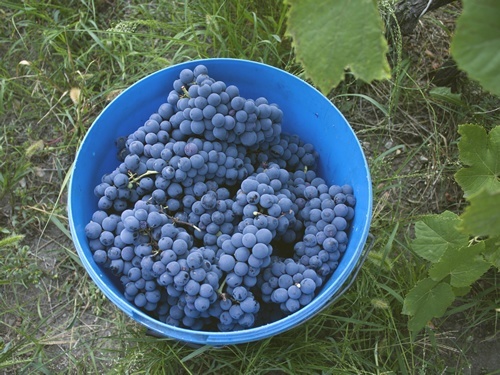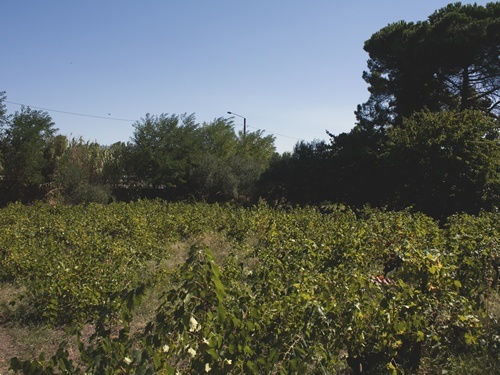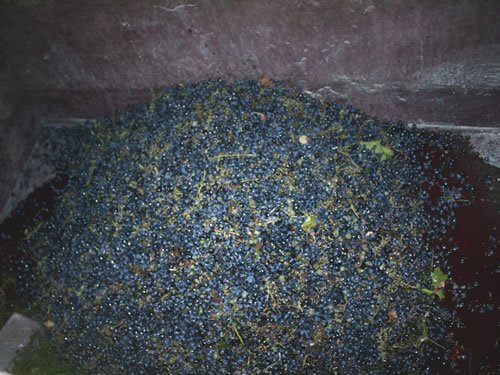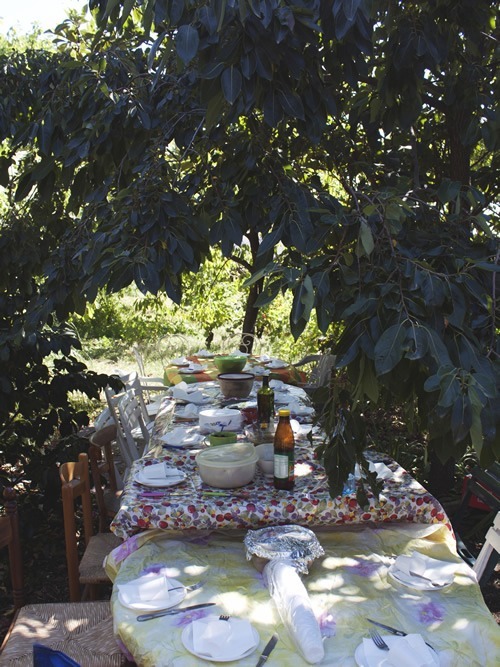Wine Grape Harvest Rituals in France
The Frenzy of the Vendanges
Article and photos by Chelsea Frischknecht

|
|
Grapes freshly harvested and collected in a barrel, destined to become wine.
|
Every September the entire French nation goes mad for grapes. September is the month of harvest — the Vendanges is a yearly ritual that every Frenchman is invested in, whether vintner, farmer, or not. Nearly every region in France produces wine, with some of the world’s most famed wines coming from otherwise unassuming valleys scattered throughout the French countryside. Wine is so vital that many families have a small plot of vines that they harvest each year. The grapes go to a communal neighborhood “cave cooperative,” where it is made into wine and redistributed according to the amount of grapes invested.

|
|
A typical small plot of grape vines that have already been harvested.
|
Spending September at my childhood home in Languedoc-Roussillon, my husband Jacob and I were bound for a crash course in winemaking. It was inescapable. We passed by the ripe vineyards every day, the fields lush and fragrant, stretching in neat rows up the hillsides. Ancient stone huts dot the fields, remnants from an earlier time, now used to house rusty farm equipment. We passed countless vineyards in the midst of harvest, often seeing the husband operating an automated harvesting machine while the wife sat on a folding chair amongst the vines, smoking a cigarette.
Every dinner party, every conversation, revolved around the famed Vendanges. People swapped experiences like merit badges, puffing with pride to share their stories of years past. One such friend, Jaki, makes a yearly pilgrimage to Bourgogne, where she earns a small fortune harvesting grapes by hand. While most contemporary vineyards harvest their grapes with machines, the best wine, the really, truly expensive bottles, are made from hand-harvested grapes. Jaki painted a picture of a strange world, a world where helicopters are hired to fly low over the grapes and whisk away the humidity in the night air. A world where the wine is so exclusive, it is reserved by the rich and famous years before the grapes are even grown. Yet, for the harvesters themselves, birthdays were celebrated with gifts of unmarked bottles of the same wine being sold for thousands of Euros.
Our education continued with a visit to my cousin’s vineyard. Guilleme is a renaissance man of farmers. His blood is in the ground. His family has farmed the land for generations, building all of their homes within a stones throw of each other. Guilleme was the first to go off to university; studying the science of the art form he had grown up with — wine making. He returned to the land and took over the family business, implementing new methods and technology. His business thrives. He has pioneered a popular Rosé infused with pineapple and grapefruit for which English tourists go wild.
As late September approached, the Vendange frenzy was mounting tangibly across the countryside. Jacob and I were thrilled when we were invited to join a Petite Vendanges — the culmination of our wine education. Every year our friends hold the same celebration: invite all of their friends to help harvest their small field of grapes, followed by a feast that lasts twice as long as the hours you actually worked.
It was sweaty, backbreaking work. The grapes cluster on the lower part of the vines, rarely growing taller than hip-level. I quickly came to appreciate why harvesters like Jaki are paid so well for their skill. Skill-less though we were, we were a merry bunch of people, with laughter and singing breaking out all across the field. Between all 20 of us, the job was finished in four hours.

|
|
All the grapes collected through hard harvest work and ready to be turned into the pulp that eventually becomes wine.
|
As the buckets of grapes grew full, we brought them to the cave — the place where the wine is made and fermented. That particular cave, we were told several times, is very, very old. Once, we were informed, King Louis XIII had slept in that very place back when it was still a village inn. Inside the cave, dark, cool, and smelling like 500-year-old mold, there was a hand-cranked machine that ground the grapes, stems and all, into a pulp. The pulp and juice were then thrown into a stone basin where it would be allowed to ferment for a few weeks before being transferred to barrels to finish aging.
The feasting began in the early afternoon. It started innocuously enough, three trestle tables laid end-to-end underneath a fig tree outside the rustic villa. The old men and women found their chairs from which they would remain unmoved, come what may. The younger people scattered among the elder deferentially, while the children ran back and forth, bringing appetizers, and wine to their elders. Bowls filled with savory pastries, nuts, and olives were passed and re-passed until emptied. Two types of wine offered, a medium-bodied Burgundy and the wine made from the previous year’s Vendanges. The house wine was stored (none too elegantly) in 1-liter water bottles, and though we truly wanted to like the wine, it tasted terrible. We had been forewarned — my parents had participated in this event in years past and cautioned us regarding the “house wine.”

|
|
Feasting preparations at tables laid out beneath a fig tree outside the rustic villa.
|
Cheers went up as the first course came out, a green salad tossed with chickpeas and vinaigrette. More wine was served. Next, a giant platter of cold sliced meats was passed — pig’s cheek, as we later identified by discovering the snout. The meats were followed by a quiche, then a stew with bread, followed by cheese, fruit, and cake. No glass of wine was ever left empty. All totaled, our post-Vendanges lunch boasted 9 courses in 5 hours.
At the end of the meal we raised our glasses to the vineyards of France, a fitting tribute to a national passion revered the world over.

|
Chelsea Frischknecht is a freelance writer, and photographer She loves people-watching, foreign languages, and drinks her whiskey on the rocks.
|
|
